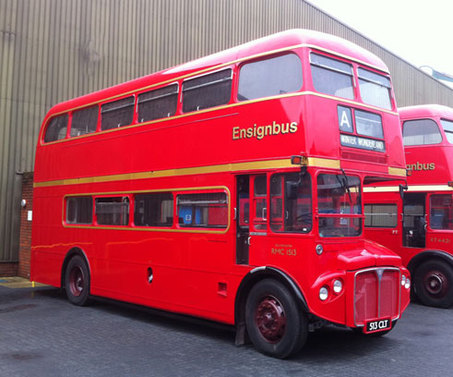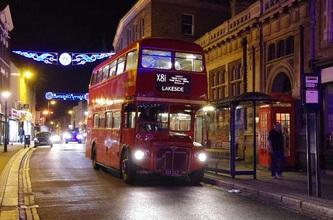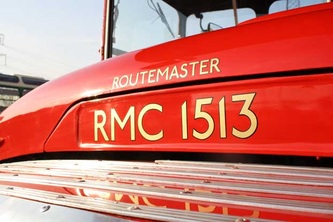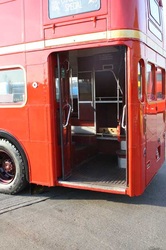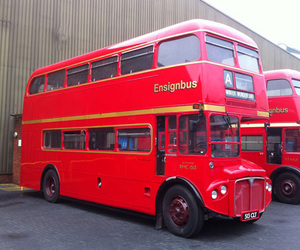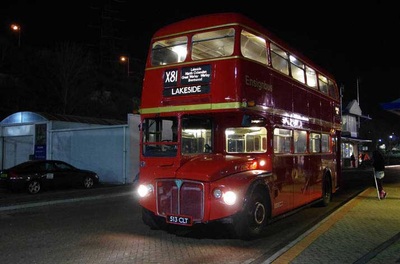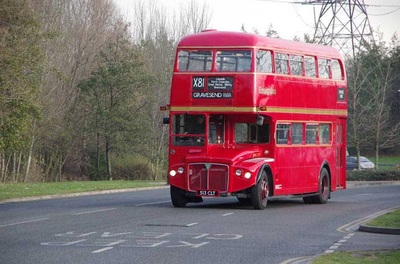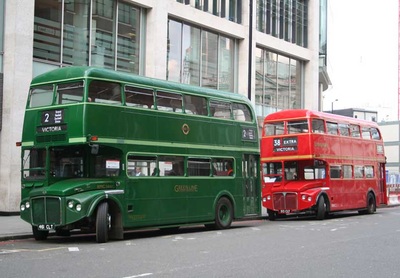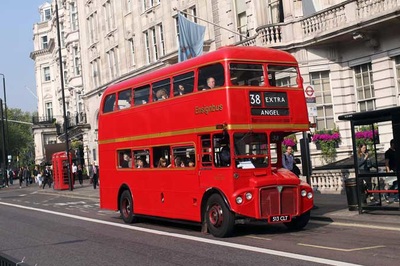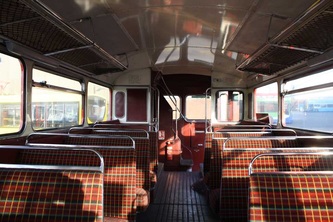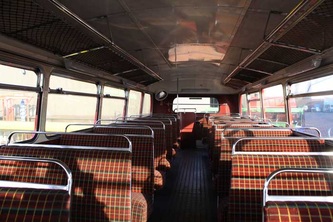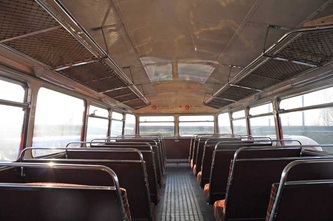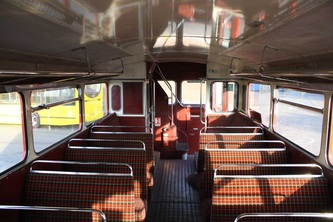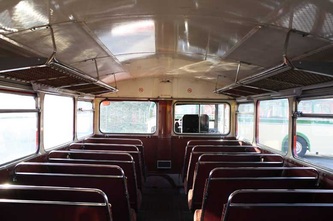Recent Photos
|
RMC1513
Seating Capacity:
58 (32 upstairs and 26 downstairs) Special features: PA system which makes this bus ideal for tours of London. Closing rear door, ideal for colder weather. Description:
One of our most popular Routemasters is the ex Green Line version that provides protection from the cold with closable doors and was built for more speed and comfort. This example maintains an original sounding engine as well much of its original interior charm, including deeper seats and luggage racking. Vehicle History
Routemaster Class History:
The Routemaster or RM is without doubt one of the most famous types of bus ever to run in the capital. The original necessity was for vehicles to replace the Trolleybus which was due for replacement in 1959. Following a lot of research it had been decided to increase the capacity of London’s buses from 56, such as the RT, to 64. Following numerous changes and nearly five years of development the RM finally entered service. By 1962 the entire Trolleybus fleet had been replaced almost exclusively by Routemasters. In this period RM8-879 were all built and had entered service. Increasing the length and capacity of the RM was another contentious point, with both the Unions and Met Police being against the idea. However in 1961 a batch of 24, 30’ long 72 seat versions, known as the RML or Routemaster Lengthened, were built to trial. These took the numbers of RML880-904. Following this batch, whilst the trial continued with the longer versions, production continued on the standard length RM producing numbers RM905-1452. The next version was the batch between RMC1453-1520, which were built as Routemaster Coaches (RMC). These had such delights as deeper more comfortable seats, Green Line livery, powered rear doors, twin headlamps and interior luggage racks and were far quicker. Following this batch production again returned to the standard RM which ran through from the number RM1521-2217 which became the very last standard length RM built. Following the success of the RMC’s the next batch to be built, which were by many, seen as the zenith of RM design being the RCL’s. These took the numbers from RCL2218-2260 and were built to replace the Green Line RT’s on the busy (but declining) routes from Essex into Aldgate. Similar in comfort levels to the RMC they were a longer and more powerful version Permission had now been granted to run the longer RML’s in Central London and the final production batch ran from RML2261-2760 were all built to this specification. Two batches of 50 of these RML’s were built for the Country Area and were delivered in Green being RML2306-2355 and RML2411-2460. The final type of RM to enter service with London Transport was the RMA, or Routemaster Airport, version which originally ran for British European Airways bringing passengers to and fro between Central London and Heathrow before the Underground was extended there. The Routemaster was gradually withdrawn from London in the 1980’s before a change of plan saw many of the longer versions (and some standard length ones) be refurbished in 1990-92 when they received new engines, lighting and seating. In 2000-01 some had another refurbishment where they were fitted with more environmentally friendly engines and new gear boxes. However, the policy changed in 2003 and the final 20 routes were given warning that at next change of contract the vehicles required would not be RM’s. One by one these routes were withdrawn with the very last, the 159’s, finishing on December 9, 2005. However, such is the popularity of this type of vehicle that around 16 were retained for use on two heritage routes in Central London. For more on this class why not visit Ian's Bus Stop RMC1513 The RMC was London Transports first attempt at a double deck coach and was aimed at keeping and indeed increasing its commuter market. 68 of these splendid vehicles were ordered of which 1513 was towards the end of the batch. RMC1513 entered service at Stevenage garage in January 1963 working mainly on the Green Line commuter route 716 and 716A. Following first overhaul it transfer to Addlestone garage where it continued to work on the 716 group of routes. Following the break up of London Transport’s Central and Country Area’s, the country area (operating the green buses) was renamed London Country and RMC1513 transferred to the new company. By this point the vehicle had again moved, this time briefly to Hatfield where it would’ve operated on the 303 as well as returning to the 716 group of services. In 1972 RMC1513 went to St Albans garage where it was used on the 330s. A string of other garages followed as the vehicle was stored and used as a trainer at Hemel Hepstead, Garston, Hatfield, Winsdor, Tring and Guildford. London Transport was at this time buying back any and all Routemasters it could get its hands on and 1513 passed back to them in July 1979 and was placed in storage at Victoria Docks almost immediately. Still wearing its green livery it was employed as a driver trainer based at Romford. Somewhat surprisingly it made a return to commuter work in 1989, when it was transferred to Upton Park garage to be used on the Express X15 service where it received a smart red and gold livery, although at this point in lost its luggage racks that were a unique feature to the Routemaster coaches. A year or so before privatisation in 1994 it passed to Metroline who repainted it out of the X15 livery and into the standard red with cream band. It was used by Metroline for various private hire work and made appearances on a number of the ‘last Routemaster days’ Withdrawn by Metroline in early 2012 with a blown engine it was acquired by Ensignbus, who in Autumn 2012, replaced the engine, reinstated the luggage racks and repainted it back into the X15 livery as an identical twin to its former stablemate RMC1485. It made its first debut with Ensignbus on the 2012 X81 Running Day on December 1. |

